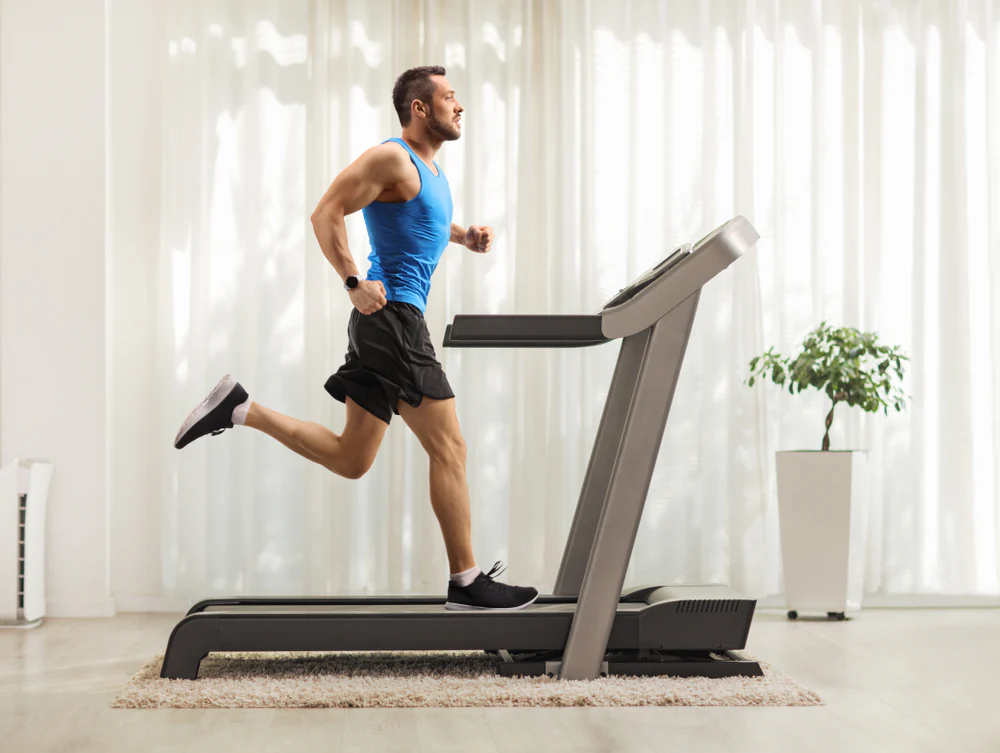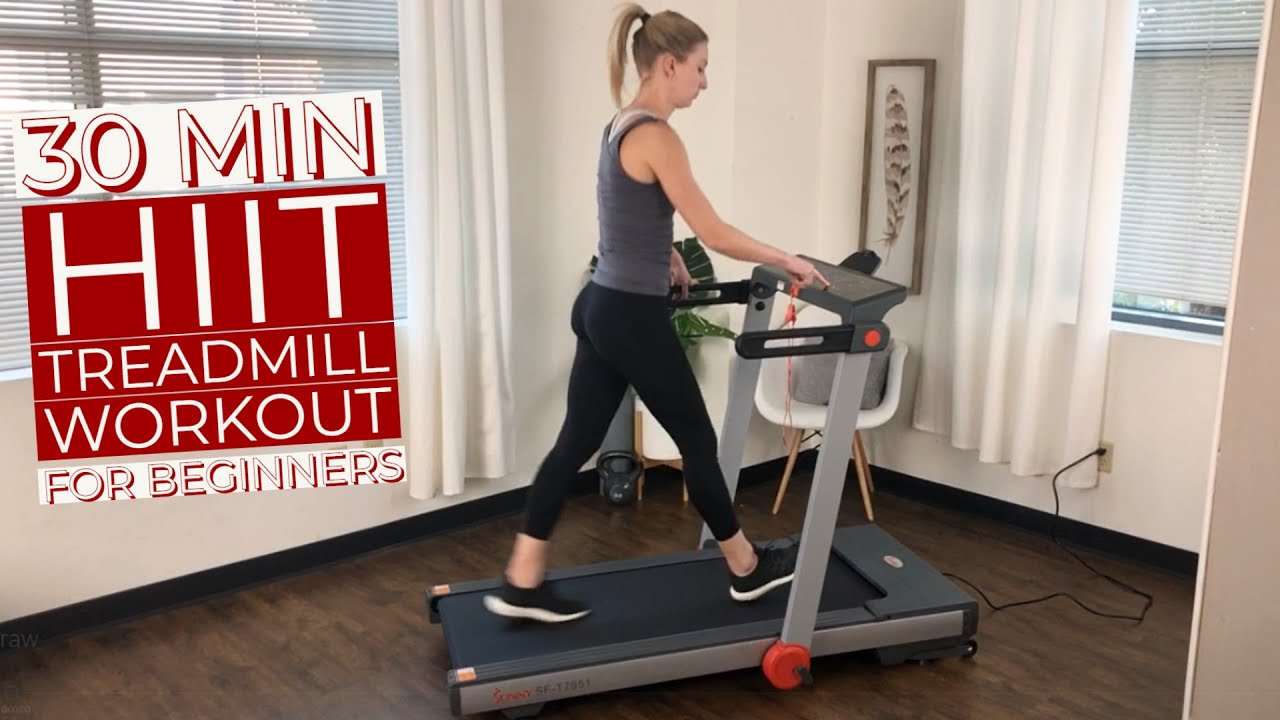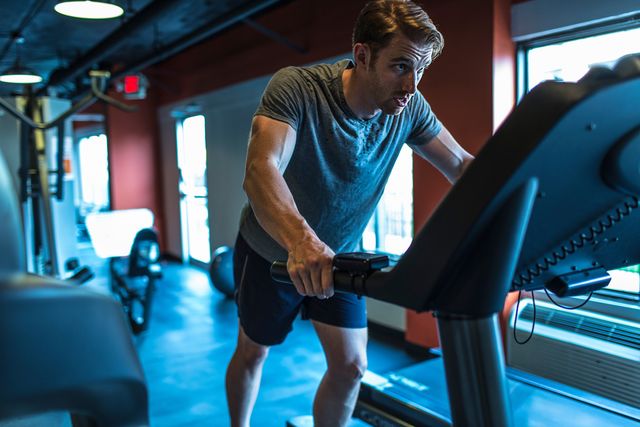Having a cardio routine is an important part of any fitness plan.
Good cardiovascular fitness reduces the risk of heart disease, lowers the risk of diabetes by up to 50%, and even promotes a great night’s sleep.
It also works wonders to maintain healthy body composition for anyone from new moms to career executives who log a lot of hours at a desk. Regular exercise also smashes stress, boosts energy, and improves people’s overall well-being.
But we understand that your schedule moves at a million miles per hour — and your fitness strategy doesn’t always keep up at that pace. About 50% of people who start an exercise program quit within 6 months, and less than 25% of adults in the US meet the recommendations for weekly physical activity.

BEGINNER TREADMILL WORKOUTS
A home treadmill is the perfect low-impact tool for beginners to progress their fitness goals because:
- Treadmills are suitable for beginner workouts
- You can work out right from your living room, day or night, rain or shine
- Treadmill exercises are adaptable, so you can mix and match beginner workouts and amp up the difficulty as you advance
- They aren’t just a way to get in your daily steps but can also offer full-body benefits
These three styles of treadmill workouts will help you to get started with your home fitness goals. They’re suited to any level, can be scaled-up once you start seeing results, and are versatile enough to sustain motivation — even if you don’t love to run.
THE BEST TREADMILL WORKOUT FOR WEIGHT LOSS
You don’t need to go all-out until you burn-out — in fact, when it comes to the best weight loss workouts, you only need about half of that effort.
Experts say that we get the best weight loss benefits based on our heart rate. This “fat-burning zone” is 50 to 70% of your maximum heart rate. For most people, this means that your breathing is sped up but you are still able to have a conversation.
Lose weight on your treadmill through these simple steps:
- Be consistent: daily brisk walking workouts add up to more calories burned than going on a run only once or twice a week.
- Start with about 20 minutes per day: The pace you set will depend on you — with low-intensity workout strategies, you should be able to breathe through your nose while exercising.
- Scale-up: work up to 60-minute walks and increase the pace to keep your heart rate in the fat-burning zone.
As your fitness improves, your workouts should become more challenging. By adding intensity, you avoid hitting a plateau in your progress.
Enhance your low-intensity workouts by adding easy equipment to your walks, like:
- A weighted vest that can help you burn up to 12% more calories
- A medicine ball or ankle weights
- Resistance bands for upper body-toning exercises
THE BEST HIIT TREADMILL WORKOUT FOR BEGINNERS
We’d all love to devote more time to our fitness goals, but too often, our schedules just aren’t on our side. High-intensity interval training (HIIT) routines maximize the impact of your treadmill workout, burning more calories in less time.
HIIT involves short bursts of high-paced exercise — about 15 to 30 seconds — alternating with rest periods. This boosts your heart rate quickly and then brings it back down, an anaerobic style of training that torches fat and increases your metabolism for up to 48 hours after your workout.
Have a great HIIT workout on your treadmill with these simple steps:
- Aim for workouts of between 15 to 25 minutes. Experts advise you only need 3 sessions per week.
- Start with 15 seconds of high intensity — going as hard as you can sprinting or climbing at a high incline.
- Get 45 seconds active rest by walking at a slow pace.
- Repeat this cycle for 25 minutes.
As your fitness improves up the pace or incline, lengthen your high-intensity intervals, and shorten rest periods. Your overall workout should still be about 25 minutes.
You can also mix up styles of high-intensity intervals to add variety to your workout. Use your treadmill for your active rest period and alternate with heart rate-boosting exercises like:
- Jumping rope
- Step-ups
- Bosu ball jumping jacks
- Mountain climbers

THE BEST TREADMILL WORKOUT IF YOU HATE RUNNING
Some people live for their next runner’s high. But if speed or incline intervals sound like your nightmare, you won’t keep up with a routine in spite of all best intentions.
Incorporating strength training exercises into your treadmill workout is an easy way to add variety while netting full-body results. Using your treadmill for active recovery between sets keeps your heart rate elevated, maximizing the effects of your routine while ensuring you’re getting cardio benefits.
How to build strength through a treadmill workout circuit:
- Start by using low weight — about 5 to 10 pounds — or try bodyweight exercises. Increase resistance as your strength builds.
- Select three to four strength training exercises for a circuit — we’ve included a few ideas below to get you started.
- Start your first 30-second exercise. Do as many repetitions as you can while maintaining good form.
- Hop on the treadmill at a brisk walking pace for up to one minute, and then move onto your next 30-second interval.
- After completing each exercise once repeat the full circuit two more times.
As your fitness improves, reduce your active rest time to 30 seconds — or you can even up the recovery pace to a light jog. Like HIIT workouts, you only need about 20 to 30 minutes for great results.

For a great full-body workout choose one exercise that targets each major muscle group for your circuit:
- Kettlebell swings
- Push-ups on your exercise mat (you can start on your knees)
- Resistance band or dumbbell bicep curls
- Dumbbell squats
- Walking lunges with a medicine ball
- Lateral resistance band walk
- Ab roller
- Crunches using an exercise ball
- Plank on your mat
No matter which treadmill workout is best for you, make sure to talk to your doctor before beginning any new exercise routine.
It’s also important to add a gentle warm-up and cool-down to every workout to reduce the risk of injury. Your warm-up can be as simple as a five-minute walk on your treadmill. Then protect your body with cool-down stretches, working out sore spots with foam rollers, and relaxing muscles with acupressure balls.
*Before you incorporate any new activity into your workout routine, remember to consult with your physician.

